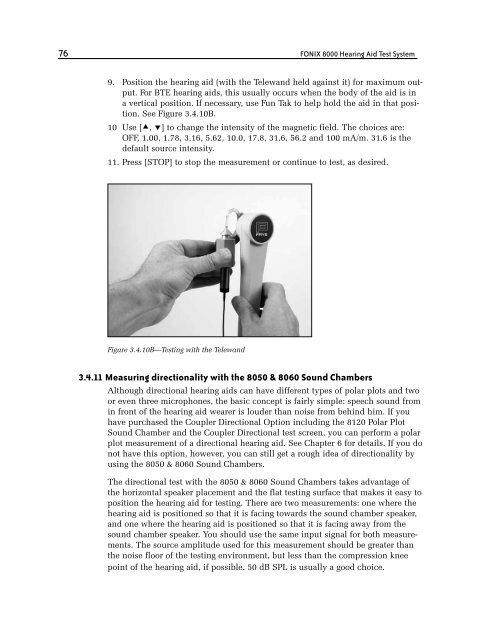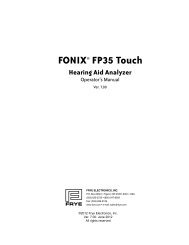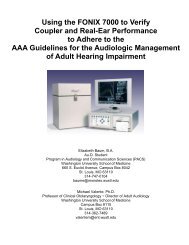FONIX® 8000 - Frye Electronics
FONIX® 8000 - Frye Electronics
FONIX® 8000 - Frye Electronics
You also want an ePaper? Increase the reach of your titles
YUMPU automatically turns print PDFs into web optimized ePapers that Google loves.
76 FONIX <strong>8000</strong> Hearing Aid Test System<br />
9. Position the hearing aid (with the Telewand held against it) for maximum output.<br />
For BTE hearing aids, this usually occurs when the body of the aid is in<br />
a vertical position. If necessary, use Fun Tak to help hold the aid in that position.<br />
See Figure 3.4.10B.<br />
10 Use [, ] to change the intensity of the magnetic field. The choices are:<br />
OFF, 1.00, 1.78, 3.16, 5.62, 10.0, 17.8, 31.6, 56.2 and 100 mA/m. 31.6 is the<br />
default source intensity.<br />
11. Press [STOP] to stop the measurement or continue to test, as desired.<br />
Figure 3.4.10B—Testing with the Telewand<br />
3.4.11 Measuring directionality with the 8050 & 8060 Sound Chambers<br />
Although directional hearing aids can have different types of polar plots and two<br />
or even three microphones, the basic concept is fairly simple: speech sound from<br />
in front of the hearing aid wearer is louder than noise from behind him. If you<br />
have purchased the Coupler Directional Option including the 8120 Polar Plot<br />
Sound Chamber and the Coupler Directional test screen, you can perform a polar<br />
plot measurement of a directional hearing aid. See Chapter 6 for details. If you do<br />
not have this option, however, you can still get a rough idea of directionality by<br />
using the 8050 & 8060 Sound Chambers.<br />
The directional test with the 8050 & 8060 Sound Chambers takes advantage of<br />
the horizontal speaker placement and the flat testing surface that makes it easy to<br />
position the hearing aid for testing. There are two measurements: one where the<br />
hearing aid is positioned so that it is facing towards the sound chamber speaker,<br />
and one where the hearing aid is positioned so that it is facing away from the<br />
sound chamber speaker. You should use the same input signal for both measurements.<br />
The source amplitude used for this measurement should be greater than<br />
the noise floor of the testing environment, but less than the compression knee<br />
point of the hearing aid, if possible. 50 dB SPL is usually a good choice.
















